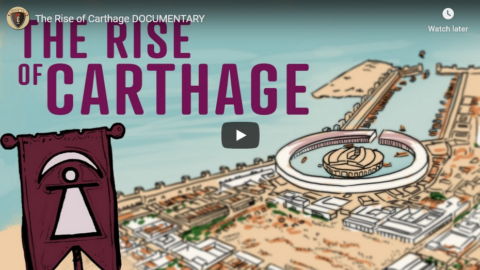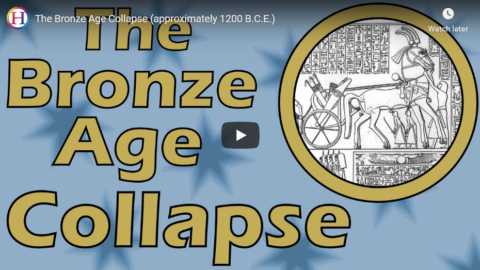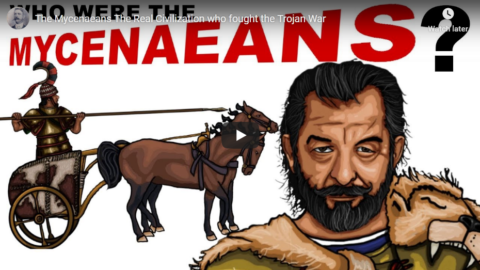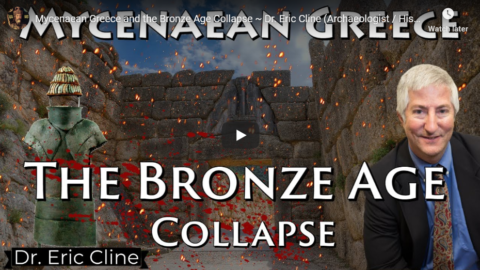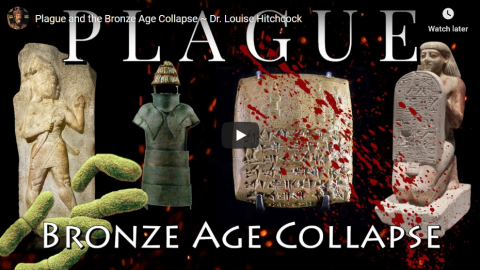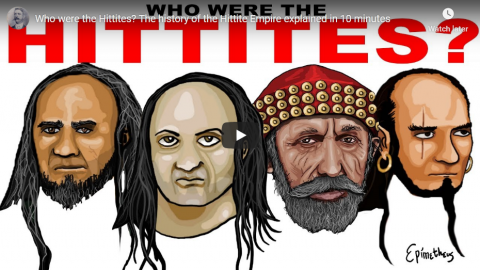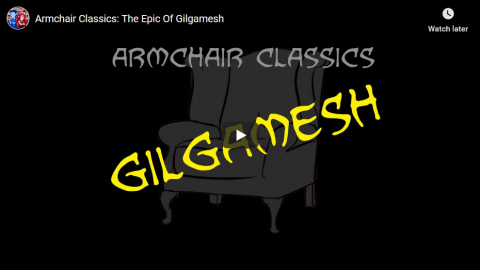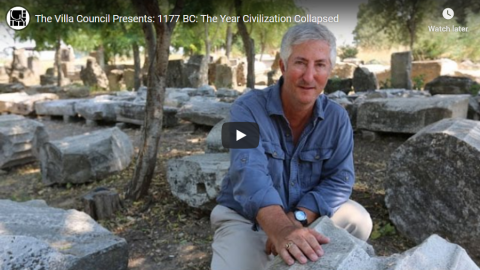Invicta
Published 13 Mar 2020Support the channel by downloading Rise of Kingdoms: http://patron.me/Invicta, New users can use the code
seyfpw6fxuand claim these prizes: GEM 200, Silver Key x2, 50000 Food x2, 50000 Wood x2Today Carthage is remembered only in the context of its dramatic fall at the end of the Punic Wars between Rome and Carthage. We all know about Hannibal and the Battle of Cannae but how about the daily life of Carthage. There is much more to this ancient civilization than the dust and ashes left to us by history. Today we will be exploring the Rise of Carthage and dive into the fascinating details of their civilization.
The history documentary begins by covering the ancient Phoenicians who planted colonies across the Mediterranean. Carthage emerged from this trade network to become the leader of the Phoenicians in the west and eventually come to forge an empire when its mother colony Tyre declined. The history documentary then turns to cover the government, economy, culture, and military of ancient Carthage.
Sources and Suggested Reading:
Carthage: A History by Serge Lancel
The Carthaginians by Dexter Hoyos
Carthage’s Other Wars by Dexter Hoyos
Carthage Must be Destroyed by Richard Miles#History
#Documentary
#Carthage
August 10, 2020
The Rise of Carthage
August 6, 2020
Rhodes: A Short History
History Time
Published 2 Mar 2017*****This was one of the first videos I ever made.
******Subscribe for much better narration on the newer videos and tons more historical awesomeness*****Situated at a crossroads between East and West, in a strategic location between the Aegean and the Mediterranean, Rhodes has long been fought over by the surrounding powers. As a result, Rhodes is one of the most historic sites on Earth.
If you liked this video and have as little as a dollar to spare then please consider supporting me on Patreon for more and better content in the future:- http://www.patreon.com/historytimeUK
Are you a budding artist, illustrator, cartographer, or music producer? Send me a message! No matter how professional you are or even if you’re just starting out, I can always use new music and images in my videos. Get in touch! I’d love to hear from you.
I’ve also compiled a reading list of my favourite history books via the Amazon influencer program. If you do choose to purchase any of these incredible sources of information, many of which form the basis of my videos, then Amazon will send me a tiny fraction of the earnings (as long as you do it through the link) (this means more and better content in the future) I’ll keep adding to and updating the list as time goes on:-
https://www.amazon.com/shop/historytimeI try to use copyright free images at all times. However if I have used any of your artwork or maps then please don’t hesitate to contact me and I’ll be more than happy to give the appropriate credit.
—Join the History Time community on social media:-
Instagram:-
https://www.instagram.com/historytime…
Twitter:-
https://twitter.com/HistoryTimePete
July 27, 2020
The Bronze Age Collapse (approximately 1200 B.C.E.)
Historia Civilis
Published 25 Jul 2020Just casually thinkin bout the end of the world. No, no reason, why?
Patreon | http://patreon.com/HistoriaCivilis
Donate | http://www.paypal.com/cgi-bin/webscr?…
Merch | teespring.com/stores/historiacivilis
Twitter | http://twitter.com/HistoriaCivilis
Website | http://historiacivilis.comSources:
The Medinet Habu Inscription | https://bit.ly/2Ba2Lvf
David O’Connor & Stephen Quirke, Mysterious Lands | https://amzn.to/3jdQOWu
—
Eric H. Cline, 1177 B.C.: The Year Civilization Collapsed | https://amzn.to/2ClWgpO
Robert Drews, The End of the Bronze Age: Changes in Warfare and the Catastrophe ca. 1200 B.C. | https://amzn.to/2CkJ7NC
Paul Kriwaczek, Babylon: Mesopotamia and the Birth of Civilization | https://amzn.to/2Wra8G4
Oliver Dickinson, The Aegean From Bronze Age to Iron Age: Continuity and Change Between the Twelfth and Eighth Centuries B.C. | https://amzn.to/3h8ar0rMusic:
“Mell’s Parade,” by Broke For Free
“Sad Cyclops,” by Podington Bear
“Infados,” by Kevin MacLeod
“Heliograph,” by Chris Zabriskie
“Deluge,” by Cellophane SamWe are a participant in the Amazon Services LLC Associates Program, an affiliate advertising program designed to provide a means for us to earn fees by linking to Amazon.com and affiliated sites.
From the comments:
ka v
1 day ago
I got Sea People Return in the December slot of my 2020 Apocalypse bingo card.
June 30, 2020
The Mycenaeans – The Real Civilization who fought the Trojan War
Epimetheus
Published 2 Nov 2018The true ancient civilization behind the Trojan war (The Iliad and Odyssey – the Greek and Trojan heroes Agamemnon, Hector, and Achilles), the Mycenaeans. The history of how they interacted with the Bronze Age world including the Egyptians and the Hittites. From the early days with the Minoans to the Trojan War and the Sea Peoples. Rediscover this lost civilization.
Help my 1 man team of me to make more videos like this, so I can have better equipment and software to make you better content. https://www.patreon.com/Epimetheus1776
I draw, write, edit, research and narrate I love it and hope to make many more videos in the future with your help. Thank you
June 22, 2020
Mycenaean Greece and the Bronze Age Collapse ~ Dr. Eric Cline (Archaeologist / Historian / 1177 BC)
The Study of Antiquity and the Middle Ages
Published 20 Jun 2020In this video we briefly discuss the Bronze Age Collapse and none other than Mycenaean Greece and what contributed to the Greek Dark Ages. Did the Sea Peoples invade? Was there an internal rebellion like a peasant revolt? Drought, Earthquakes and Famine? We cover a variety of topics which also includes debunking the Dorian Invasion. We also take a look at migrations and depopulations of major centers as populations moved elsewhere during this calamity.
Support Dr. Eric Cline at the links below!
Personal web page: https://ehcline.com
GW pages:
https://cnelc.columbian.gwu.edu/eric-…
https://anthropology.columbian.gwu.ed…
https://gwu.academia.edu/EricClineArchaeology and the Iliad: The Trojan War in Homer and History
https://www.amazon.com/dp/B001EI3IVU?…The History of Ancient Israel: From the Patriarchs Through the Romans
https://www.amazon.com/dp/B001JHT8CY?…Image credits: Manna Nader, Gabana Studios Cairo
Hittite 3D City and intro footage credits: 3D reconstruction of Imperial Hittite Karkemish by Giampaolo Luglio, Turco-Italian Archaeological Expedition to Karkemish directed by Nicolò Marchetti (University of Boologna)
KARKEMISH (Carchemish) 1300 BC (3D) -The Southern Capital of the Empire Hittite
Music Attribution: Herknungr – Megaliths | Dark Neolithic Meditive Shamanic Ambient Music https://youtu.be/oc8FQwNjPu0
June 16, 2020
Plague and the Bronze Age Collapse ~ Dr. Louise Hitchcock
The Study of Antiquity and the Middle Ages
Published 16 May 2020Ladies and Gentlemen, welcome to the series NAUE II SWORDS, GERMS, & IRON brought to us by none other than Dr. Louise Hitchcock and this episode is going to be about plague and the Bronze Age collapse. This episode will also be drawing on modern parallels such as “What Covid-19 Can Tell Us About the Bronze Age (12th cent) Collapse?”
It will dive into the Bronze Age and discuss was plague a contributing factor in decline of the Bronze Age and the birth of the Iron Age? How familiar were the ancient peoples with plague and epidemics and what do the ancient literary sources tell us? From discussing plague in ancient Mesopotamia to the Philistine Plague to a Hittite King who falls prey to a deadly disease we explore new thoughts, theories and research involving a period that we all love and a subject that could not be more relevant and that is plague.
Check out the awesome work of Dr. Hitchcock at these links below!
Academia profile where you can access her work that is free to the public. https://unimelb.academia.edu/LouiseHi…
Get her books here!
Aegean Art and Architecture: https://global.oup.com/ukhe/product/a…
Minoan Architecture: A Contextual Analysis: http://www.astromeditions.com/books/b…
Theory for Classics: https://www.routledge.com/Theory-for-…
DAIS: The Aegean Feast https://www.peeters-leuven.be/detail….
Tell It In Gath: Studies in the History and Archaeology of Israel. Essays in Honor of Aren M. Maeir on the Occasion of his Sixtieth Birthday https://www.zaphon.de/epages/83179382…Follow her on Twitter: https://twitter.com/ashlarblocks
To support the channel, become a patron and make history matter!
Patreon: https://www.patreon.com/the_study_of_…
Donate directly to paypal: https://paypal.me/nickbarksdale
Enjoy history merchandise? Check out our affiliate link to spqr emporium! http://spqr-emporium.com?aff=3
*disclaimer, the link above is an affiliate link which means we will earn a generous commission from your magnificent purchase, just another way to help out the channel! join our community!twitter: https://twitter.com/nickbarksdale
instagram: https://www.instagram.com/study_of_an…Image credits: Manna Nader, Gabana Studios Cairo
Hittite 3D City and intro footage credits: 3D reconstruction of Imperial Hittite Karkemish by Giampaolo Luglio, Turco-Italian Archaeological Expedition to Karkemish directed by Nicolò Marchetti (University of Boologna)
KARKEMISH (Carchemish) 1300 BC (3D) – The Southern Capital of the Empire Hittite https://youtu.be/RsTdoY__F4U
Music Attribution: Herknungr – Megaliths | Dark Neolithic Meditive Shamanic Ambient Music https://youtu.be/oc8FQwNjPu0
Footage of Ugarit Credit goes to Ruptly. Video Title : Syria: Ancient city of Ugarit freed from Islamic State control https://youtu.be/XKzbk0PFvg0
June 2, 2020
Who were the Hittites? The history of the Hittite Empire explained in 10 minutes
Epimetheus
Published 30 Nov 2018Who were the Hittites? (The Hittite Empire explained in 10 minutes) Animated history
Support new videos from Epimetheus on Patreon!
https://www.patreon.com/Epimetheus1776
April 8, 2020
QotD: Iliad, Odyssey, and Anabasis
I read the trio in the order listed above and the reading got better with each title.
The Iliad is epically epic, rendered in a stiff dactylic hexameter with many, many, many repeating phrases. Between “rosy-fingered dawn” and “the wine-dark sea,” Homer’s epithets lull the reader into a trance, which I suppose was the point in oral storytelling. As a result, the myriad battles and names start blending together.
But, man, those battles are brutal. The semi-divine soldiers are walking Cuisinarts, leading to lovely vignettes like this:
Next Erymas was doom’d his fate to feel,
His open’d mouth received the Cretan steel:
Beneath the brain the point a passage tore,
Crash’d the thin bones, and drown’d the teeth in gore:
His mouth, his eyes, his nostrils, pour a flood;
He sobs his soul out in the gush of blood.Spoiler alert: Erymas didn’t make it. As you can see, I read the older translations of these works; the above is Alexander Pope’s translation. I wanted the feel of the original, so I didn’t hunt down the modern versions. All three books are decidedly un-“woke.”
For The Odyssey, I chose the Harvard Classics version translated by Samuel Butler. This epic was far more interesting (and fun!) than the grim, brain-splattered Iliad. Ulysses slides into a Mediterranean port, feasts on great food, charms exotic women, grabs a pile of loot, and is off to the next isle.
Granted, the fellow gets in a few scrapes along the way, even being forced into love slavery by an eternally gorgeous nymph (poor guy), but returns home after 20 years to wreak vengeance on the cads trying to bed his wife. (Monogamy was pretty much a one-way street in ancient Hellas.)
After reading both of Homer’s works, I think The Iliad is geared toward young men, especially those of a military mindset. It’s all heroism, glory, and honor. I really should have tackled this in my Navy days.
The Odyssey is an even better adventure, but its themes of home, wisdom, fatherhood, and marriage are aimed squarely at those of us with more mileage on the drivetrain. The heroes still kill their share of monsters and men, but Ulysses always chooses brains before brawn.
The real revelation for me was Anabasis by Xenophon. How Hollywood hasn’t released a trilogy of this epic is beyond me. (No, The Warriors doesn’t count.) Here are the Cliffs Notes for this real-life tale:
Cyrus the Younger wants to topple his brother Artaxerxes II from the Persian throne, so he recruits 10,000 Greek mercenaries (including Xenophon) to help. They march 1,500 miles from the east coast of modern-day Turkey to the middle of modern-day Iraq and, in the first big battle, Cyrus is killed.
Uh oh.
Now, the entire Persian army opposes the Greeks. The pro-Cyrus Persians say, “No actually, we were for Artaxerxes the whole time!” and turn against the Greeks. The Hellenic generals ask the King for safe passage … and he murders them.
Xenophon is more a philosopher than soldier, but he gives an inspiring speech, the troops elect him leader, and they all hightail it due north while anyone, everyone, and everything tries to kill them.
They cross deserts and rivers and mountains through searing heat, waist-deep snow, and constant attacks from ahead and behind by an ever-hostile collection of bronze-age barbarians. Upon hitting Turkey’s north shore, they finally enter a Greek colony. Happy ending, right? Well, that’s when the soldiers start turning on each other.
Granted, Anabasis is an amazing war story, but it also serves as a history, an ancient travel guide, and a primer in leadership, group dynamics, and human nature.
If you haven’t read any of these three books, you should make up that deficit.
Jon Gabriel, “My Month in Ancient Greece”, Ricochet, 2018-01-23.
March 29, 2020
Armchair Classics: The Epic Of Gilgamesh
Overly Sarcastic Productions
Published 17 Aug 2015CONTENT DISCLAIMER: This video no longer meets my standards of quality for historical research and presentation. I made this one in the days long past, when the question of “How do I make an entertaining and historically interesting video” was answered by “IDK, memes I guess?”. Take the video above with a grain of salt and enjoy the jokes for now. We have a replacement planned, so stay tuned.
Hailing from Mesopotamia, it’s the Epic Of Gilgamesh!
Gregory brings you yet another dose of knowledge from the comfort of his comfy chair.
March 22, 2020
Sargon of Akkad: History’s First Emperor?
History Time
Published 31 Oct 2017A brief look at Sargon of Akkad, an Akkadian whose conquests of the Sumerian plain have led many scholars to cite him as one of the earliest, if not the earliest emperors in history. Agree? Disagree? Comment below!
Music:-
“Assyrian Fortress” by Derek & Brandon FiechterIf you liked this video and have as little as a dollar to spare then please consider supporting me on Patreon for more and better content in the future: http://www.patreon.com/historytimeUK
Are you a budding artist, illustrator, cartographer, or music producer? Send me a message! No matter how professional you are or even if you’re just starting out, I can always use new music and images in my videos. Get in touch! I’d love to hear from you.
I’ve also compiled a reading list of my favourite history books via the Amazon influencer program. If you do choose to purchase any of these incredible sources of information, many of which form the basis of my videos, then Amazon will send me a tiny fraction of the earnings (as long as you do it through the link) (this means more and better content in the future) I’ll keep adding to and updating the list as time goes on:-
https://www.amazon.com/shop/historytimeI try to use copyright free images at all times. However if I have used any of your artwork or maps then please don’t hesitate to contact me and I’ll be more than happy to give the appropriate credit.
February 11, 2020
QotD: Agriculture and the rise of the state
Why should cereal grains play such a massive role in the earliest states? After all, other crops, in particular legumes such as lentils, chickpeas, and peas, had been domesticated in the Middle East and, in China, taro and soybean. Why were they not the basis of state formation? More broadly, why have no “lentil states,” chickpea states, taro states, sago states, breadfruit states, yam states, cassava states, potato states, peanut states, or banana states appeared in the historical record? Many of these cultivars provide more calories per unit of land than wheat and barley, some require less labor, and singly or in combination they would provide comparable basic nutrition. Many of them meet, in other words, the agro-demographic conditions of population density and food value as well as cereal grains. Only irrigated rice outclasses them in terms of sheer concentration of caloric value per unit of land.
The key to the nexus between grains and states lies, I believe, in the fact that only the cereal grains can serve as a basis for taxation: visible, divisible, assessable, storable, transportable, and “rationable.” Other crops — legumes, tubers, and starch plants — have some of these desirable state-adapted qualities, but none has all of these advantages. To appreciate the unique advantages of the cereal grains, it helps to place yourself in the sandals of an ancient tax-collection official interested, above all, in the ease and efficiency of appropriation.
The fact that cereal grains grow above ground and ripen at roughly the same time makes the job of any would-be taxman that much easier. If the army or the tax officials arrive at the right time, they can cut, thresh, and confiscate the entire harvest in one operation. For a hostile army, cereal grains make a scorched-earth policy that much simpler; they can burn the harvest-ready grain fields and reduce the cultivators to flight or starvation. Better yet, a tax collector or enemy can simply wait until the crop has been threshed and stored and confiscate the entire contents of the granary.
Compare this situation with, say, that of farmers whose staple crops are tubers such as potatoes or cassava/manioc. Such crops ripen in a year but may be safely left in the ground for an additional year or two. They can be dug up as needed and the reaminder stored where they grew, underground. If an army or tax collectors want your tubers, they will have to dig them up tuber by tuber, as the farmer does, and then they will have a cartload of potatoes which is far less valuable (either calorically or at the market) than a cartload of wheat, and is also more likely to spoil quickly. Frederick the Great of Prussia, when he ordered his subjects to plant potatoes, understood that, as planters of tubers, they could not be so easily dispersed by invading armies.
The “aboveground” simultaneous ripening of cereal grains has the inestimable advantage of being legible and assessable by the state tax collectors. These characteristics are what make wheat, barley, rice, millet, and maize the premier political crops. A tax assessor typically classifies fields in terms of soil quality and, knowing the average yield of a particular grain from such soil, is able to estimate a tax. If a year-to-year adjustment is required, fields can be surveyed and crop cuttings taken from a representative patch just before harvest to arrive at an estimated yield for that particular crop year. As we shall see, state officials tried to raise crop yields and taxes in kind by mandating techniques of cultivation; in Mesopotamia this included insisting on repeated ploughing to break up the large clods of earth and repeated harrowing for better rooting and nutrient delivery. The point is that with cereal grains and soil preparation, the planting, the condition of the crop, and the ultimate yield were more visible and assessable.
James Scott, Against The Grain: A deep history of the earliest states, 2017.
January 13, 2020
QotD: Early civilizations and the barbarians
The book [Against The Grain] ends with a chapter on “barbarians”. Scott reminds us that until about 1600, the majority of human population lived outside state control; histories that focus on states and forget barbarians are forgetting about most humans alive. In keeping with his thesis, Scott reviews some ancient sources that talk about barbarians in the context of people who did not farm or eat grain. Also in keeping with his thesis, he warns against thinking of barbarians as somehow worse or more primitive. Many barbarians were former state citizens who had escaped state control to a freer and happier lifestyle. Barbarian tribes could control vast trading empires, form complex confederations, and enter in various symbiotic relationships with the states around them. Scott wants us to think of these not as primitive people vs. advanced people, but as two different interacting lifestyles, of which the barbarian one was superior for most people up until a few centuries ago.
Scott Alexander, “Book Review: Against The Grain“, Slate Star Codex, 2019-10-15.
October 30, 2019
Homer, the Trojan War & the Late Bronze Age Collapse
History Time
Published 20 Mar 2018This is the first in a new series I will be producing on the Late Bronze Age Collapse.
If you enjoyed this video and would like to see more then please consider supporting me on Patreon:-
https://www.patreon.com/historytimeUK (every dollar helps)Are you a budding artist, illustrator, cartographer, or music producer? Send me a message at petekellywriter@gmail.com No matter how professional you are or even if you’re just starting out, I can always use new music and images in my videos. Get in touch! I’d love to hear from you.
I’ve compiled a reading list of my favourite history books via the Amazon influencer program. If you do choose to purchase any of these incredible sources of information then Amazon will send me a tiny fraction of the earnings (as long as you do it through the link) (this means more and better content in the future) I’ll keep adding to and updating the list as time goes on:-
https://www.amazon.com/shop/historytimeI try to use copyright free images at all times. However if I have used any of your artwork or maps then please don’t hesitate to contact me and I’ll be more than happy to give the appropriate credit.
October 9, 2019
The Villa Council Presents: 1177 BC: The Year Civilization Collapsed
Getty Museum
14 Jun 2016Noted historian and archaeologist Eric Cline discusses the themes of his Pulitzer Prize-nominated book 1177 BC: The Year Civilization Collapsed and takes a closer look at why Mediterranean societies of the Late Bronze Age — with their complex cosmopolitan and globalized world-systems — came to a dramatic halt. He considers the similarities and parallels of our contemporary civilization, making the chain of interconnected events more than simply a study of ancient history.
Photo: Blink Films
May 22, 2016
The Getty Villa, Malibu, CaliforniaFind out what’s on now at the Getty:
http://www.getty.edu/360/
#gettytalks
August 11, 2019
QotD: Deconstructing “Minoan Crete”
In many ways, “Minoan” Crete seemed like a Freudian paradise. Here the archaeologists unearthed colourful frescoes of naked-breasted women participating in the dangerous “bull-vaulting” game, whilst statuettes of bare-breasted goddesses, holding writhing snakes in each hand, emerged from various parts of the island. Evans spoke glowingly of a pacifist matriarchy that flourished before the coming of the warlike and patriarchal Greeks, and his vision was hugely influential in academic circles for at least half a century. It is a vision which has been humorously outlined by Rebecca Bradley on the dust-cover of her book, Goodbye, Mother: The Warriors of Crete: “Once upon a time, on an olive-strewn island in a wine-dark sea, beautiful people lived in peace under the rule of the Great Goddess and her matriarchal avatars. The like of their palaces was not seen again until the advent of shopping-mall architecture in the twentieth century; their artistry flowered like the saffron blossoms collected by their luscious bare-breasted maidens. This was Minoan Crete, stronghold of the Matriarchy and the Great Goddess, flower child of the ancient world — until those nasty patriarchal Mycenaeans and even nastier Dorians came along and crashed the party. Oh yes, and there’s something about a volcano on Santorini, and a few earthquakes as well, but the rot really set in when the men from the mainland took over.”
Perhaps the most prominent high priestess of the Great Goddess was Lithuanian archaeologist Marija Gimbutas (1921-1994). During the 1950s and 60s Gimbutas developed her so-called “Kurgan Thesis;” basically the idea that the archaeological marker of the arrival in Europe of Indo-European-speakers was to be found in the Bronze Age Kurgan mound burials of the Pontic Steppe, a vast region incorporating most of present-day Ukraine, southern Russia and northern Kazakhstan. Controversially, Gimbutas further claimed that these nomadic Indo-Europeans brought with them a warrior-culture dominated by male sky-gods, which supplanted earlier matriarchal and goddess-worshipping cultures. In this, she echoed ideas already expressed at great length by Robert Graves in his 1948 book The White Goddess. Over the next three decades Gimbutas developed her ideas further in a series of books, articles and lectures delivered at campuses throughout America and Europe, where she was immensely influential amongst the burgeoning women’s movement. Three major works, The Goddesses and Gods of Old Europe (1974), The Language of the Goddess (1989), and The Civilization of the Goddess (1991), presented an overview of her conclusions regarding what she saw as Europe’s primeval matriarchy.
The importance of Gimbutas in the development of the matriarchal myth, and also by extension in the development of modern radical feminism, cannot be overstated. Her archaeological experience and expertise, together with her wide knowledge of linguistics and anthropology, seemed to give academic credibility to the romantic and poetic ramblings of Arthur Evans and Robert Graves. Yet in retrospect it is hard to imagine why anyone with even a modicum of common sense could have been taken in.
There were warning signals everywhere. Right from the beginning, for example, many historians were critical of Evans’ interpretation of Minoan Crete, and a devastating blow was delivered in 1974 when German author Hans Georg Wunderlich published his Wohin der Stier Europa trug? (Where did the Bull carry Europa? published in English in 1975 as The Secret of Crete). Here Wunderlich, a trained geologist, examined the structure of the “palace” of Knossos in Crete in detail and came to the conclusion that the building could never have been a palace for the living. It was, instead, a charnel house, a massive necropolis which doubled as an arena for human sacrifice. For the happy-go-lucky “bull vaulting game”, said Wunderlich, was nothing of the sort: it was a ferocious form of human sacrifice which involved young men and women being gored and trampled to death by a sacred bull. This, said Wunderlich, was the origin of the legend of the Minotaur. Since Wunderlich’s time human sacrifice has been confirmed as an integral part of Cretan religious practice, whilst the supposed “pacifism” which Evans and others had imagined, was exposed as nonsensical.
Emmet Scott, “The Myth of the Primeval Matriarchy”, The Gates of Vienna, 2016-07-13.

